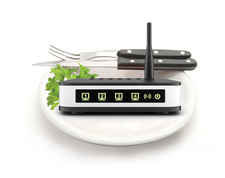Pervasive vulnerabilities in SOHO routers
SO HOpelessly Broken

Home and small office networks typically place their security in the hands of an inexpensive device that serves as a router, DHCP server, firewall, and wireless hotspot. How secure are these SOHO router devices? We're glad you asked …
Small office/home office (SOHO) routers are a staple networking appliance for millions of consumers. SOHO routers are often the single point of ingress and egress from a SOHO network, managing domain name resolution, firewall protection, dynamic addressing, wireless connectivity, and, of course, routing. The heavy use of SOHO routers in the consumer market, as well as the targeted demographic of non-computer-savvy users, has not surprisingly led to some very easy-to-use turnkey solutions.
The list of known vulnerabilities for SOHO routing devices is long (Figure 1), and our research revealed 56 previously undisclosed security vulnerabilities in SOHO devices. The alarming quantity of these security problems demonstrate how the rich service and feature sets (e.g., SMB, NetBIOS, HTTP(S), FTP, UPnP, and Telnet) implemented in these routers comes at a significant cost to security. All the extraneous services running within these SOHO routers expose attack surfaces that a malicious adversary can leverage to compromise the router core and gain a foothold in the victim network.
Once compromised, any router – SOHO or otherwise – may be used by an adversary to secure a man-in-the-middle position for launching more sophisticated attacks against all users in the router's domain. The attacks could include sniffing and rerouting all network traffic, poisoning DNS resolvers, performing denial of service attacks, or impersonating servers. Worse still is that these routers are also firewalls and often represent the first and last line of defense for protecting the local network. Once compromised, the adversary has unfettered access to exploit the vulnerabilities of local area hosts that would be otherwise unreachable if the router were enforcing firewall rules as intended.
[...]
Buy this article as PDF
(incl. VAT)
Buy Linux Magazine
Subscribe to our Linux Newsletters
Find Linux and Open Source Jobs
Subscribe to our ADMIN Newsletters
Support Our Work
Linux Magazine content is made possible with support from readers like you. Please consider contributing when you’ve found an article to be beneficial.

News
-
OpenMandriva Lx 6.0 Available for Installation
The latest release of OpenMandriva has arrived with a new kernel, an updated Plasma desktop, and a server edition.
-
TrueNAS 25.04 Arrives with Thousands of Changes
One of the most popular Linux-based NAS solutions has rolled out the latest edition, based on Ubuntu 25.04.
-
Fedora 42 Available with Two New Spins
The latest release from the Fedora Project includes the usual updates, a new kernel, an official KDE Plasma spin, and a new System76 spin.
-
So Long, ArcoLinux
The ArcoLinux distribution is the latest Linux distribution to shut down.
-
What Open Source Pros Look for in a Job Role
Learn what professionals in technical and non-technical roles say is most important when seeking a new position.
-
Asahi Linux Runs into Issues with M4 Support
Due to Apple Silicon changes, the Asahi Linux project is at odds with adding support for the M4 chips.
-
Plasma 6.3.4 Now Available
Although not a major release, Plasma 6.3.4 does fix some bugs and offer a subtle change for the Plasma sidebar.
-
Linux Kernel 6.15 First Release Candidate Now Available
Linux Torvalds has announced that the release candidate for the final release of the Linux 6.15 series is now available.
-
Akamai Will Host kernel.org
The organization dedicated to cloud-based solutions has agreed to host kernel.org to deliver long-term stability for the development team.
-
Linux Kernel 6.14 Released
The latest Linux kernel has arrived with extra Rust support and more.

